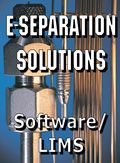Ask the Editor: The Evolution of Flash Chromatography
E-Separation Solutions
Flash chromatography was first introduced by W.C. Still in 1978. The following report published in the June 2006 issue of LCGC North America provided a good overview of the technique.
An LCGC reader recently asked:
How has flash chromatography evolved since its introduction back in the late '70s?
Flash chromatography was first introduced by W.C. Still in 1978 (1). The following report entitled "Flash Chromatography" published in the June 2006 issue of LCGC North America (2) provided a good overview of the technique:
"Flash chromatography is a type of preparative liquid chromatography commonly used in the separation of organic compounds. When purifying organic compounds, few techniques are as easy, inexpensive, and speedy as flash chromatography. Flash chromatography has become a popular method of normal-phase separation through purification. While flash chromatography is typically a low-pressure technique, scientists are using vacuums or pumps at medium pressures to speed the separation process. The columns are packed with a silica adsorbent of defined particle size usually between 40-60 mm. Mobile phases with low viscosity require smaller particle sizes. While traditional flash chromatography required scientists to pack their own columns, many of them have turned to one-time use, premade flash cartridges.
Flash chromatography is used to scale up normal-phase chemistries from thin layer chromatography. Demand for flash chromatography comes primarily from the pharmaceutical, biotech, petrochemical, and agrochemical industries. The pharmaceutical industry uses flash chromatography for a wide range of applications including purification of small compounds, peptides, and purification of natural products.
The overall market for flash chromatography continues to be strong, particularly in the life science market. Synthesis of organic compounds and peptides continue to fuel growth for flash systems. In fact, flash chromatography systems are expected to grow double-digits over the next five years. Flash is concentrated heavily in North America and Europe, which account for about 80% of the total market."
References
(1) W.C. Still, M. Kahn, and A. Mitra, J. Org. Chem. 43, 2923–2925 (1978).
(2) LCGC 24(6), 552 (2006).
Questions?LCGC technical editor Steve Brown will answer your technical questions. Each month, one question will be selected to appear in this space, so we welcome your submissions. Please send all questions to the attention of "Ask the Editor" at lcgcedit@lcgcmag.com. We look forward to hearing from you.
New Method Explored for the Detection of CECs in Crops Irrigated with Contaminated Water
April 30th 2025This new study presents a validated QuEChERS–LC-MS/MS method for detecting eight persistent, mobile, and toxic substances in escarole, tomatoes, and tomato leaves irrigated with contaminated water.
University of Tasmania Researchers Explore Haloacetic Acid Determiniation in Water with capLC–MS
April 29th 2025Haloacetic acid detection has become important when analyzing drinking and swimming pool water. University of Tasmania researchers have begun applying capillary liquid chromatography as a means of detecting these substances.
Prioritizing Non-Target Screening in LC–HRMS Environmental Sample Analysis
April 28th 2025When analyzing samples using liquid chromatography–high-resolution mass spectrometry, there are various ways the processes can be improved. Researchers created new methods for prioritizing these strategies.

.png&w=3840&q=75)

.png&w=3840&q=75)



.png&w=3840&q=75)



.png&w=3840&q=75)









